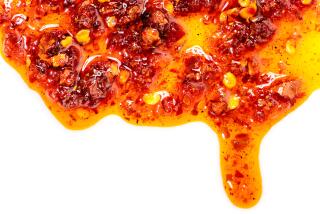The ultimate mapo tofu recipe has a California twist
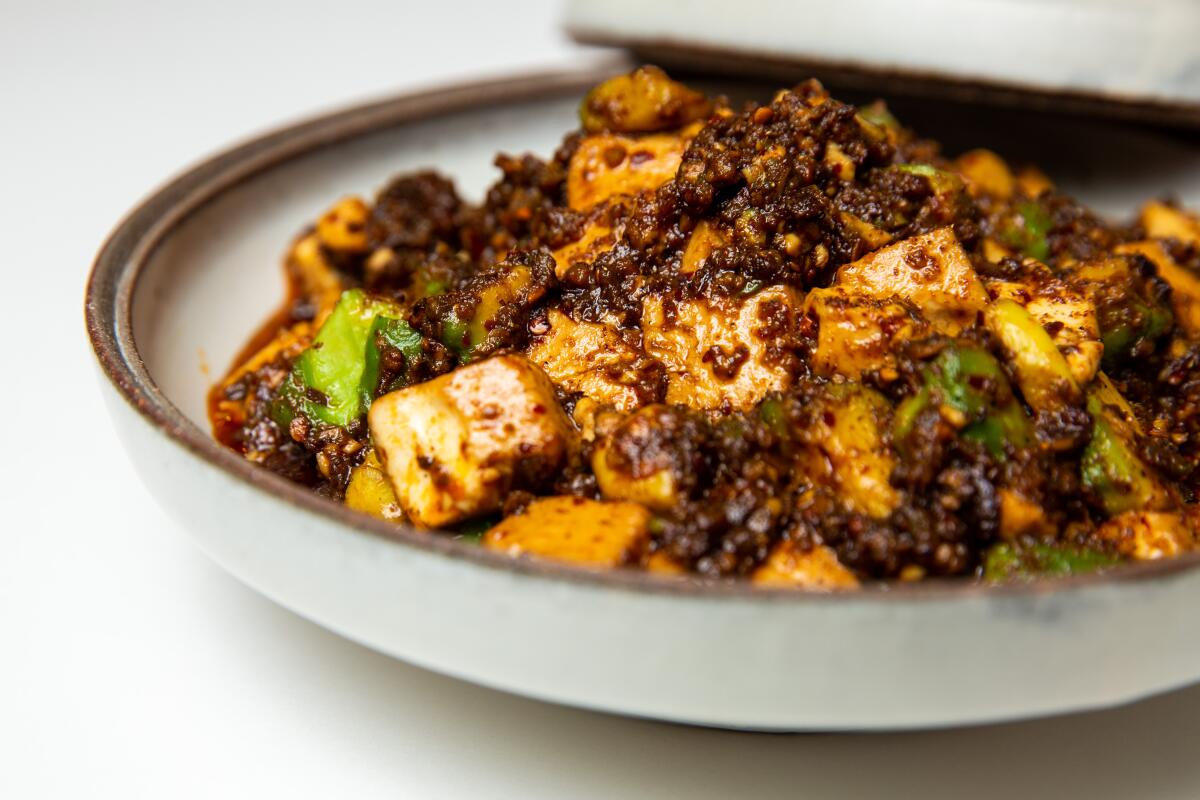
Yu Bo and his wife, Dai Shuang, gained international fame with their restaurant Yu’s Family Kitchen in Chengdu, China; consuming the painstakingly crafted and beautiful 16 cold dishes that begin every meal, each dish highlighting a different ingredient and distinct flavor, is practically a rite of passage for anyone interested in Sichuan cooking.
The couple now split their time between Chengdu and Los Angeles, closing the restaurant when they leave and opening it when they’re there. (It will be open again this December until March 2020.) They are searching for a permanent stateside space to introduce America to their intricate, banquet-influenced style of Sichuan cooking that also strives to be playfully forward-thinking — a sweet and sour Jerusalem artichoke, for instance, or sweet sticky rice pudding redolent with savory bits of pork.
Experimenting at pop-up dinners in Los Angeles (most recently in conjunction with our Food Bowl event in May), Yu has created a twist on mapo tofu, the beloved Sichuan folk dish, by adding chunks of ripe avocado to the mix. And it’s good. It’s really, really good. This isn’t peas in guacamole, I promise.
In Sichuan province, mapo tofu — chunks of soft bean curd swimming in glowing red oil flecked with meat and tasting of peppercorns and funky black soybeans — is historically a working person’s dish.
The origin of mapo tofu is now the stuff of legend, like Paul Bunyan or Gungnir. Sometime during the latter half of the 19th century, Yu explained, laborers used to transport cooking oil in large baskets made from bamboo and leather. One day, some laborers stopped by a small roadside establishment in Chengdu and asked the proprietress, a woman known as Chen Ma Po due to the mazi, or pockmarks, on her face, to make them a dish with the cooking oil they were schlepping and whatever ingredients were handy. Chen created her famous dish, and slid into the pages of Chinese cooking lore.
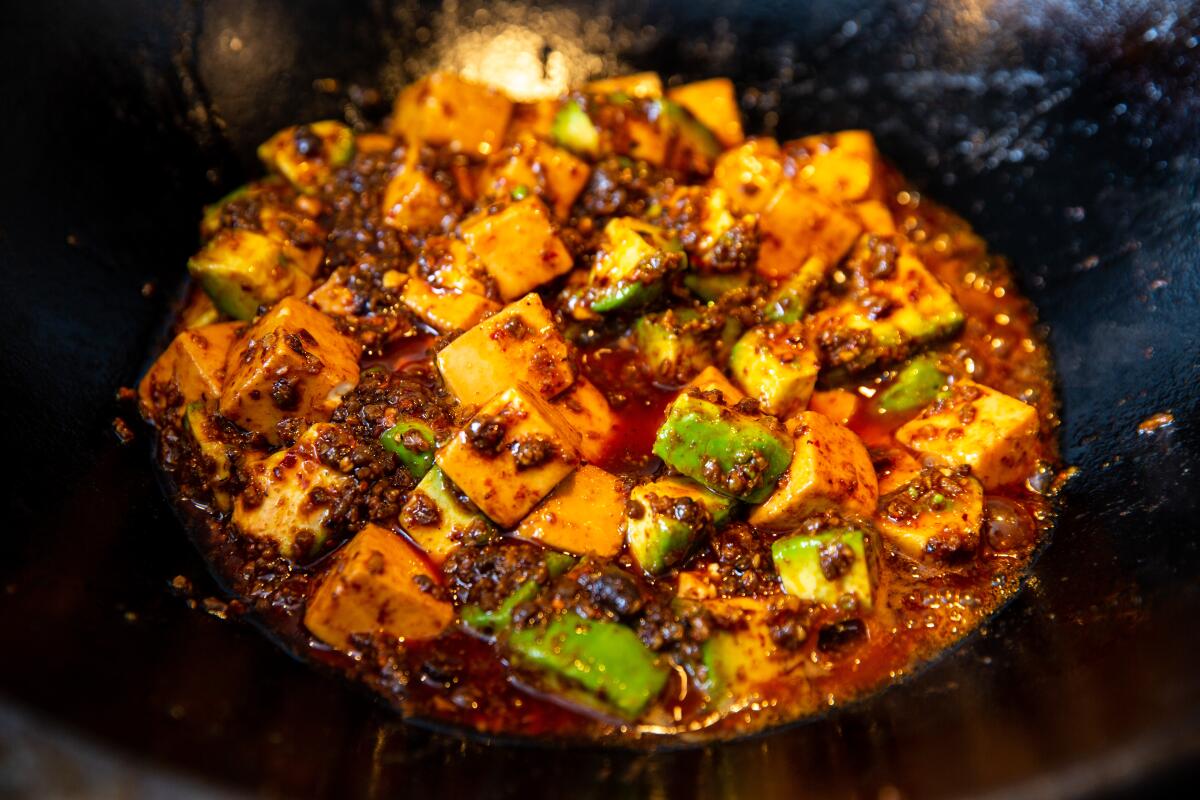
Mapo tofu also happens to be a dish that I love: I literally have a mapo tofu vanity license plate on my car. I’m not just the mapo tofu president, I’m also a client. It’s delicious and it’s comforting. It’s home.
So I was fascinated to visit Yu’s home in the San Gabriel Valley recently and watch a master craft his take on the dish. I was particularly interested to see that Yu uses relatively little doubanjiang, the fermented bean paste that is a workhorse of the Sichuan kitchen, and uses beef instead of the pork that is more commonly seen in U.S. restaurants.
“You have to do it with beef,” Yu said, and proceeded to school me in the balancing and harmonizing of flavors — a tenet central to Chinese cooking.
Sichuan food is synonymous with spiciness and heat. But according to Yu, perhaps the most famous chef to come out of Chengdu, it’s simply an indelible part of the cuisine, like water in a Monet landscape. Spiciness is “just a component,” he said. “It’s an entry point to understanding the cuisine.”
Every ingredient has positive and negative qualities, he explained. “Using the negative qualities of different ingredients to cancel each other out creates a beautiful and harmonious overall mouthfeel.”
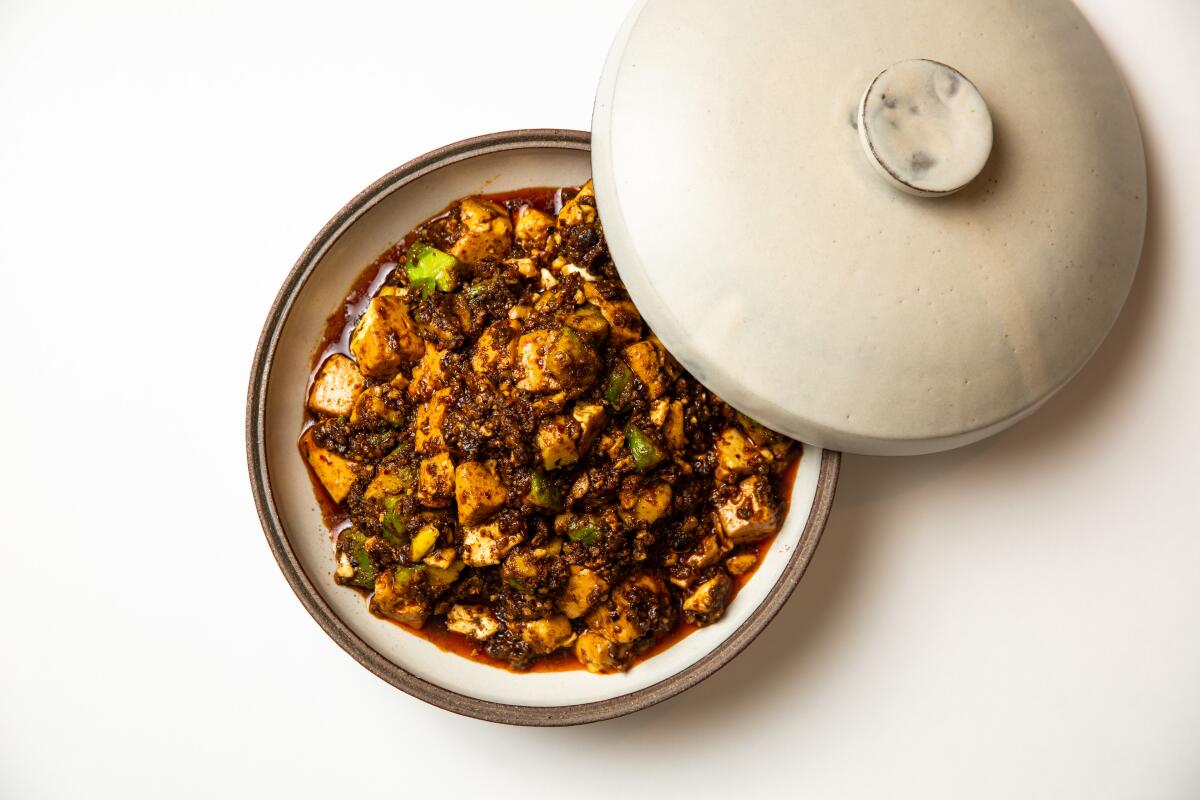
For instance, in a freshly opened package of tofu, that quality is called xing. It doesn’t translate well to English, he explained, but it’s an undesirable taste that approaches fishy, something that’s just a little bit off. In beef, the undesirable quality is called shen, a gamey quality found mostly in red meat. The shen and xing, he said, negate each other.
The other surprise came when I realized that Yu’s mapo tofu isn’t a quick dish, whipped up in a matter of minutes in a searing hot wok. His mapo tofu is simmered over low heat for a good amount of time. “This technique is called du,” he said, carefully folding a bit more chicken broth into the mixture. The onomatopoetic term comes from the sound a gently simmering pot night make. Du-du-du-du-du.
While he was cooking, Yu returned time and time again to the concepts of balance and harmony. “The tofu is the zhuliao,” he said — the lead ingredient, like a lead character on a television show. “The beef is the fuliao,” or the supporting ingredient. And in this iteration of the dish, the avocado is the guest.
It’s an ideal match. The creamy avocado chunks provide a subtle but distinct texture contrast to the silky tofu, and a wonderful balance to the chili-fueled heat and numbing peppercorn. The restaurant Ming Ting in Chengdu famously makes a version of mapo tofu with pig’s brains; the effect of the avocado in this case is parallel.
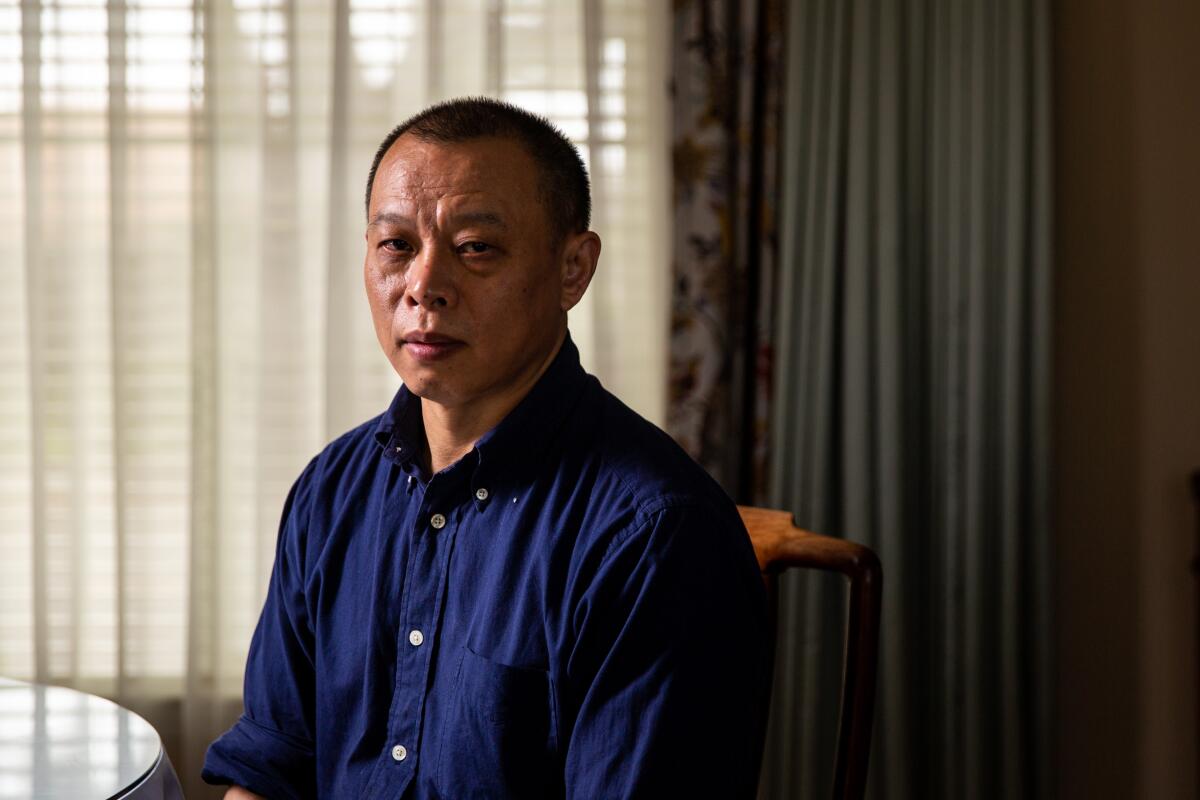
“For the Chinese palate, avocado is a little rich,” Yu said. “But you’ve got that numbing spiciness that kind of gets rid of the cloying heaviness.” In a traditional version, he said, he would use garlic sprouts in place of the avocado.
But “traditional” is a relative term and Sichuan cuisine as we know it, relative to the long history of China, is practically a newborn. Centuries of conquest in the Sichuan Basin, Yu explained, created numerous breaks and discontinuances in the evolution of a cohesive regional cuisine. In the 1600s during the Ming dynasty, he said, a massive genocide perpetrated by Zhang Xianzhong wiped out a huge swath of the population. Sichuan province, an agricultural powerhouse known as the country’s breadbasket, suffered particularly acutely during the Great Leap Forward, when Mao Zedong’s economic and social reforms devastated farming yields.
Sichuan also has a long history of hosting waves of migrants from different areas of China, Yu said — notably from Guangdong to the south and Jiangnan to the east — that has resulted in an emulsification of flavors and techniques that make up modern Sichuan cooking.
Yu’s mapo tofu takes the spicy, hearty and pleasingly numbing dish and kicks it into a higher gear I didn’t realize the dish had. The addition of avocado, a California twist, is — and I don’t always love this term — fusion cuisine at its finest. In this case, the phrase is apt. It quite literally melds two traditions to create something different, elevated and surprising. We would be fortunate if all food that called itself “fusion” could do the same.
Avocado Mapo Tofu
About 25 minutes, plus marinating time. Serves 4.
Ingredients
- ¼ pound lean ground beef
- 2 teaspoons ground Sichuan peppercorn
- 2 tablespoons dark soy sauce
- 5 green onions
- ¼ cup vegetable oil
- 4 big garlic cloves, chopped
- 2 teaspoons chopped ginger
- 2 ½ tablespoons red pepper powder
- 2 tablespoons fermented black soybeans
- 2 teaspoons doubanjiang (broad bean paste)
- 1 cup chicken stock
- 1 ½ teaspoons thick soy sauce
- ¾ teaspoons sugar
- ¼ teaspoon ground black pepper
- 3 tablespoons cornstarch slurry made with 1 tablespoon cornstarch, 2 tablespoons cold water
- 1 package soft tofu
- 1 large avocado, cut into medium-sized chunks
- Salt to taste
For the meat
Add the dark soy sauce and 1 teaspoon of ground Sichuan peppercorn to the meat. Mix and let sit in the fridge for 15 to 20 minutes. (For the peppercorns, you’re probably buying them whole. The bag might say “prickly ash” instead of “Sichuan peppercorns” — that’s fine. Grind them up.)
Add 3 tablespoons of water to a 6-inch frying pan. Do not add oil. Cook meat with the white parts of the green onions over medium heat. Cook the meat down and break it into tiny bits as it cooks. After the water is gone, continue to cook the meat and break it into smaller bits. Do this for a little longer than feels right. You want to be left with tiny meat nubs. Remove the onions.
Instructions
- Fill a large bowl with water and a pinch of salt. Slice tofu into approximately ¾-inch cubes and let soak in the salt water solution for five minutes. About a minute before you’re ready to add the tofu to the wok, transfer the tofu to a hot water bath.
- Heat the oil in a large wok over low heat, coating the surface thoroughly. Add the garlic and cook until aromatic. Add the ginger, red pepper powder, soybeans and doubanjiang and cook for 2 minutes. Add the chicken stock and increase heat slightly to bring to a low boil, then reduce heat again.
- Add beef and cook for 2 minutes. (Transfer your tofu to a hot water bath at this point.) Carefully add the tofu (the hot water will have softened it) and simmer for a couple more minutes. You want to try to maintain that simmering du that Yu Bo spoke of. Du- du-du-du-du-du.
- Add the sweet soy sauce, black pepper and sugar. Simmer another five minutes or so, stirring carefully every so often. The tofu is delicate, so it’s best to use a spatula or something with flexible edges so as not to break up the chunks.
- Loosen up the cornstarch slurry (which will have settled) and add a third of it to the wok, pouring into the liquid (not on top of the tofu), and stir. Add the avocado and cook for 2 minutes, then add another ⅓ of the slurry. Cook 2 more minutes, stirring every now and again, before adding the rest of the slurry. Yu emphasizes meting out the slurry slowly, as opposed to dumping it all in at once.
- Simmer for 5 minutes, then add the remaining ground Sichuan peppercorn (you can add more or less here, depending on your taste and the quality of your peppercorns) and mix carefully. Simmer for 2 minutes and remove from heat. Yu judges whether the tofu is fully cooked by whether the sharp edges of the tofu cubes have softened, or “collapsed,” as he puts it. Serve with rice.
Recipe adapted from Yu Bo.
More to Read
Eat your way across L.A.
Get our weekly Tasting Notes newsletter for reviews, news and more.
You may occasionally receive promotional content from the Los Angeles Times.
